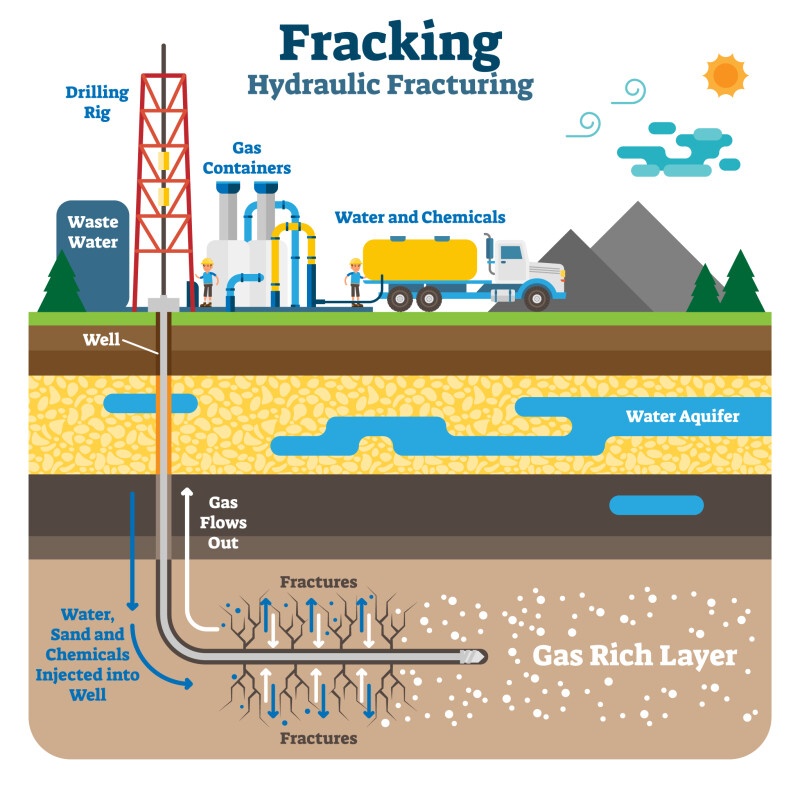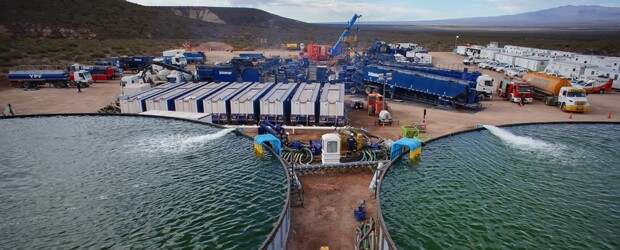In 2010, upon a request from Congress, the EPA set out to determine the relationship between hydraulic fracturing, commonly known as fracking, and drinking water. The report that resulted, Hydraulic Fracturing for Oil and Gas: Impacts from the Hydraulic Fracturing Water Cycle on Drinking Water Resources in the United States, was revised twice before the final version was released in 2016, and the determinations tend to be more qualitative than quantitative. Today, fracking continues to be a hot button topic in public discourse.
Let’s learn more about fracking and explore the determinations made in the EPA’s report on fracking and water quality.
What is Fracking?
Hydraulic fracturing uses pressure to pump sand, water and other fluids into underground rock formations to boost the flow of oil and gas into a wellbore, which is a hole drilled to allow for the exploration of natural resources.1 Fracturing as a means of obtaining gas and oil can be traced back to 1865. Edward A.L. Roberts, a Civil War Union veteran, was the first to get a patent on his “exploding torpedo” as a method for improving oil production based on observations he made on the results of Confederate artillery rounds shooting into a narrow canal during a battle.2
Fracturing continued to evolve over the ensuing decades, with the first commercial use of hydraulic fracturing occurring in 1949. It has only grown as a means of oil production since. The United States saw a 1,204 percent increase in wells between 2000 (~23,000 wells) and 2015 (~300,000 wells).3
The Hydraulic Fracturing Water Cycle
The hydraulic process goes through five stages from start to finish:4
- Water Acquisition: Obtaining the water to use in for hydraulic fracturing
- Chemical Mixing: Adding chemical additives (many of which are proprietary) to the water, effectively creating a hydraulic fracturing fluid
- Well Injection: Inserting the hydraulic fracturing fluids into the well in the production zone
- Produced Water Handling: Collecting the wastewater that comes back through the well
- Wastewater Disposal and Reuse: Management of the wastewater, either through disposal or reuse

Each step of the water cycle was examined by the EPA to determine the impact on drinking water resources as public concern around fracking began to grow.
Environmental Concerns Related to Fracking
Hydraulic fracturing is a highly regulated process. While it is typically regulated at the state level, federal laws for the protection of the environment and public health apply. Fracking is regulated under the Clean Air Act, the Clean Water Act, the Resources Conservation and Recovery Act and the Comprehensive Environmental Response, Compensation, and Liability Act. However, hydraulic fracturing is exempt from the Safe Drinking Water Act, both in the initial 1974 act and the 2005 revision, leaving states to regulate fracking as it pertains to drinking water.4
Proponents of fracking say it boasts a number of economic benefits and poses few health and safety risks, while opponents argue that fracking has negative environmental impacts, both known and unknown. In 2010, Congress requested the EPA launch a study on the effects of fracking on drinking water as public concern began to grow around this potential outcome of the fracking process.
Findings in the EPA’s Report on Fracking
The first draft of the EPA’s report was released in June of 2015. In this version of the report, the EPA wrote that it did not find any evidence that fracking caused widespread impacts on drinking water.5 But after a public meeting that year to discuss the results, the EPA’s Science Advisory Board released a final peer-reviewed report for public comment and review, releasing the final report in December 2016. In this version, the statement about lack of evidence was omitted.
The final report considered new information. The EPA reviewed around 1,200 cired sources of information and data, but concluded that there were data gaps and uncertainties that made it challenging to assess the impact of fracking on drinking water on a local and national level. The EPA stated that thorough information was either “not collected, not publicly available or prohibitively difficult to aggregate.”4
Despite the challenges in data collection, the EPA did note that drinking water can be impacted under some circumstances:4
- When water withdrawals for hydraulic fracturing are done in areas of low water availability
- When spills occur during the handling of hydraulic fracturing fluids in in high volumes or concentrations and reach the groundwater
- When fracking fluids are injected into wells with inadequate mechanical integrity
- When hydraulic fracturing fluids are injected directly into the groundwater
- When inadequately treated fracking wastewater is discharged into to surface water
- When hydraulic fracturing wastewater is stored unlined pits
The EPA was not able to make any conclusions about the frequency of these types of circumstances. The final report could only provide qualitative information on factors that could lead to a negative impact on drinking water at the local level.
Tackle the Legal Issues Facing the Energy and Environmental Sectors
Discussions around processes like fracking, and any ensuing regulations at the state or national level, require input from individuals with legal expertise. Tulane University Law School is proud to offer the Master of Jurisprudence (MJ) degrees in Environmental Law and Energy Law.
The MJ in Environmental Law offers up-to-the-minute training in the ever-evolving regulations that impact participants on all sides of environmental issues. If you work in one of these regulated entities, regulatory bodies or advocacy groups, this is your opportunity to develop expertise across the field of environmental law and learn to appreciate its impact on all potential stakeholders. This is a regulatory system that has a profound global impact and demands deep knowledge of the relevant legal frameworks.
The MJ in Energy Law is geared toward those working in or adjacent to heavily regulated energy industries like oil, gas, electric or nuclear power, where precise knowledge of the legal frameworks determine success. Gain the tactical, practical legal training to support regulators and regulated professionals in these complex fields, as well as members of advocacy groups and other organizations influencing public policy and its enforcement.
Both MJ programs are delivered online and backed by the reputation of the 12th oldest law school in the U.S. Ready to get started? Speak with our admissions team or start your application today.
- Retrieved October 20, 2021, from https://www.epa.gov/hfstudy
- Retrieved October 21, 2021, from aoghs.org/technology/hydraulic-fracturing/
- Retrieved October 21, 2021, from ballotpedia.org/Fracking_in_the_United_States
- Retrieved October 20, 2021, from epa.gov/sites/default/files/2016-12/documents/hf_final_assessment_fact_sheet.pdf
- Retrieved October 21, 2021, from ballotpedia.org/The_EPA_study_on_fracking_and_drinking_water_resources_(2016)


